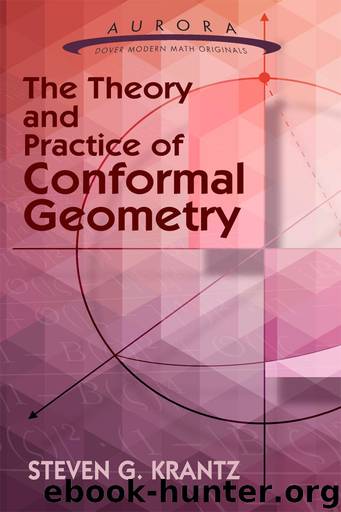The Theory and Practice of Conformal Geometry by Krantz Steven G.;

Author:Krantz, Steven G.; [Isteven G. Krantz]
Language: eng
Format: epub
Publisher: Dover Publications
Published: 2015-02-26T16:00:00+00:00
* * *
1These issues are related to Hilbert’s fifth problem, which asked whether any locally Euclidean group is a Lie group. See [BRO] and [TAU].
2It should be stressed that it is a priori clear that these two domains cannot be conformally equivalent because they are not even topologically equivalent. After all, D is simply connected while A is not. But our point is to see how automorphism groups can be used to obtain useful results.
3It is also worth noting that one automorphism group (for the annulus) is abelian while the other (for the disc) is not. Details are left for an exercise.
4It is worth noting that the conformal self-maps of the plane are just those conformal self-mappings of the sphere that map ∞ to ∞. When we pass from mappings of the plane to mappings of the sphere, we have the extra latitude of moving the point at ∞ to another point on the sphere—and that gives two more degrees of freedom. That is why dim(Aut ) = 6 and dim(Aut ()) = 4.
5For example, in the simple case that the domain is the annulus A = {z ∈ : 1/2 < |z| < 2}, the automorphism group is the set of all rotations plus the inversion z 1/z plus compositions of the two. Topologically, this automorphism group is two circles. So the automorphism group has two connected components.
6Here the orbit of P is defined to be {ϕ(P) : ϕ ∈ Aut (U)}.
7A group is said to be nilpotent if there is an integer K so that any commutator of order K in the group is the identity.
Download
This site does not store any files on its server. We only index and link to content provided by other sites. Please contact the content providers to delete copyright contents if any and email us, we'll remove relevant links or contents immediately.
| Algebraic Geometry | Analytic Geometry |
| Differential Geometry | Non-Euclidean Geometries |
| Topology |
Modelling of Convective Heat and Mass Transfer in Rotating Flows by Igor V. Shevchuk(6406)
Weapons of Math Destruction by Cathy O'Neil(6215)
Factfulness: Ten Reasons We're Wrong About the World – and Why Things Are Better Than You Think by Hans Rosling(4713)
A Mind For Numbers: How to Excel at Math and Science (Even If You Flunked Algebra) by Barbara Oakley(3256)
Descartes' Error by Antonio Damasio(3248)
Factfulness_Ten Reasons We're Wrong About the World_and Why Things Are Better Than You Think by Hans Rosling(3216)
TCP IP by Todd Lammle(3155)
Fooled by Randomness: The Hidden Role of Chance in Life and in the Markets by Nassim Nicholas Taleb(3080)
Applied Predictive Modeling by Max Kuhn & Kjell Johnson(3041)
The Tyranny of Metrics by Jerry Z. Muller(3028)
The Book of Numbers by Peter Bentley(2931)
The Great Unknown by Marcus du Sautoy(2662)
Once Upon an Algorithm by Martin Erwig(2622)
Easy Algebra Step-by-Step by Sandra Luna McCune(2604)
Lady Luck by Kristen Ashley(2554)
Police Exams Prep 2018-2019 by Kaplan Test Prep(2516)
Practical Guide To Principal Component Methods in R (Multivariate Analysis Book 2) by Alboukadel Kassambara(2513)
All Things Reconsidered by Bill Thompson III(2371)
Linear Time-Invariant Systems, Behaviors and Modules by Ulrich Oberst & Martin Scheicher & Ingrid Scheicher(2346)
